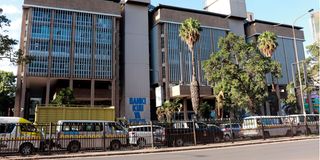Central Bank rate should be no higher than 1.5pc; here’s why

The Central Bank of Kenya's head office in Nairobi. The choice for the general level of interest rates seems free for any central bank to determine.
Interest is the cost of credit. It is the amount we agree to pay lenders for using their money and accounting for various risks. For instance, our business could fail, making it difficult for us to repay the lender.
Since we carry different levels of risk there are various interest rates in the economy.
There is the lending rate that banks charge you for a loan. Microlenders both licensed and those who are not, charge you higher.
Then there is the savings rate that you get for your deposits. The inter-bank rate is what banks charge their colleagues for overnight lending. The treasury bill rate is what we demand, and the government is willing to pay when it borrows from us for short periods of time such as one month or ninety days.
And then there is the all-important Central Bank rate. This policy rate influences all others. Central Bank of Kenya (CBK) uses it as the key lever of monetary policy.
When CBK believes there is too much money chasing few goods – hence inflation - it raises the rate, slowing down consumption and investments, bringing inflation down. When CBK wants to stimulate growth, it will lower the rate, driving up consumption and investments.
The general relationships – that central banks worldwide raise rates to control inflation and vice versa are broadly accepted. Kenyan headline inflation in November and December 2022 slowed to 9.6 per cent and 9.5 per cent respectively. The CBK will no doubt take credit, pointing to the slowdown as evidence that raising the Central Bank rate to 8.75 per cent is working.
Neutral rate of interest
But the choice for the general level of interest rates seems free for any central bank to determine. In recent times the concept of a neutral rate of interest has become widely accepted and used by central banks as they determine the policy rate. The neutral rate is that which neither restrains nor stimulates economic growth. It is therefore the long-term rate likely to promote stable inflation.
This neutral rate has been in a downward trend for decades. There is no agreement as to why, but most point to weak productivity growth in many countries and the shortage of safe assets. Low neutral rates imply short-term interest rates could frequently hit zero or fall into negative territory. So what is happening around the world?
Japan, Denmark, Sweden and Switzerland have been experimenting with negative interest rates for several years. And although conventional economics remains anxious about risks and side effects, most agree that these policies have stimulated economic activity in those countries.
Here are a few choices by countries with similar or smaller economies as ours.
Morocco’s bank rate is at 2 per cent, having increased it by 50 basis points in September to combat inflation, running at 8 per cent. At 42 billion US dollars in 2022, they have an economy half the size of Kenya’s. Seychelles’ central bank rate was 2 per cent as of October 2022. Their US$ 1.32 billion economy is growing at 11 per cent per year!
Barbados is at 2 per cent central bank rate. Their US$ six billion economy was growing at 10.5 per cent in 2022. New Caledonia is at 1.5 per cent, while Thailand is at 1 per cent.
Comoros (US$ 1.24 billion GDP) next door, was at .92 per cent mid-2022. Others are lower still. Cambodia (US$ 27 billion GDP) was at .73 per cent in August 2022. Fiji was at .25 per cent in October, as was Cape Verde in the west coast. Bulgaria (US$ 86 billion) was at 0 per cent in 2022.
There is no reason to continue with the high-interest rate regime.
@NdirituMuriithi, is an economist





